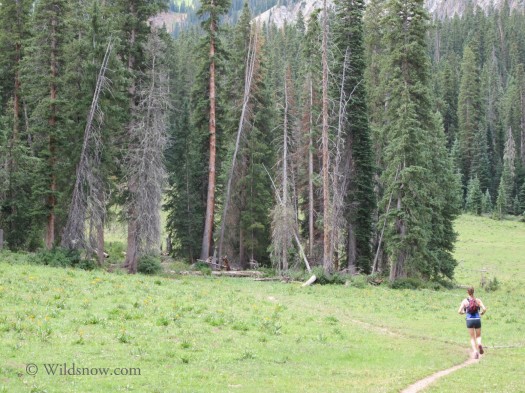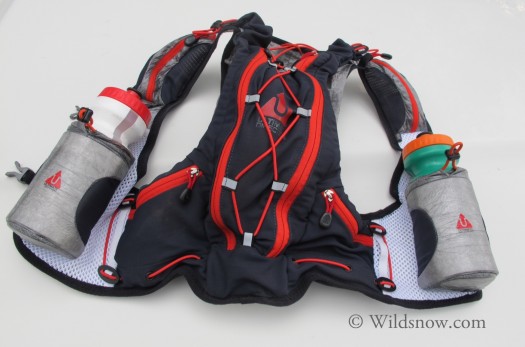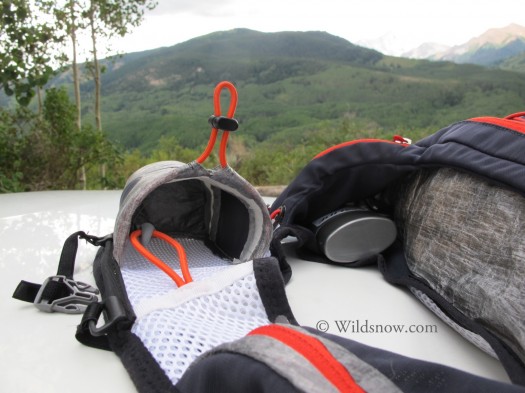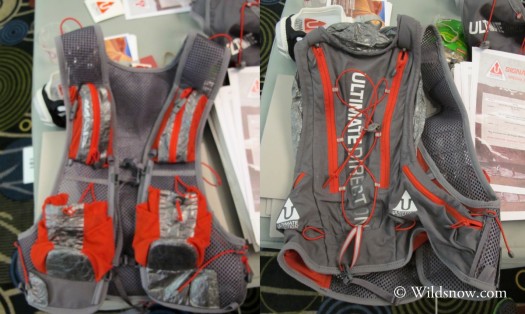
The PB Adventure Vest in action. The Capitol Ditch Trail is a 12-mile out-and-back to Capitol Lake from the Capitol Lake Trailhead. Capitol Ditch’s climb is a bit more forgiving than Capitol Creek Trail, which you can jump on from the same trailhead. The trail climbs 2,100 feet to Capitol lake, with an ending elevation of 11,600 feet. Every foot is worth it, as the Maroon Bells/Snowmass Wilderness area is beautiful and you can’t beat the view of Capitol Peak once you’ve reached your goal. One day my goal will be the top of Capitol Peak.
Bottles, bladders, belts, packs — how am I going to carry my water? In a hydration world normally dominated by the likes of Camelbak and Nathan, Colorado-based company Ultimate Direction is pushing the boundaries of how we approach backcountry hydration. Ultimate Direction is cooking up a new series of hydration packs designed by athletes who know what not to do in the backcountry. With their new Signature Series proudly on display at the summer Outdoor Retailer Show 2012, Ultimate Direction let me take a version of the PB Adventure Vest out for a test drive.

The pack’s sizing is important for stability and bottle position, so be sure to try one on. I ran with the S/M which put the bottles in a somewhat awkward position for my arms when hiking -- an issue the M/L pack would remedy.
Like a puzzle I put together every time I head out for a trail run I question how to carry everything I need without feeling like I’m carrying everything I need. I’ve done hand bottles, belts, and bladder packs. With hand bottles, I end up feeling like a juggling act — driven by fatigued neurosis to constantly switching hands and hand positions. Anyone who’s ever run with a hydration belt through gastrointestinal distress will tell you there must be better options. Bladder packs are by far the most popular design these days but refilling a bladder in the backcountry is far more difficult than a couple of bottles.
Ultimate Direction’s Signature Series features three packs designed by ultramarathoning moguls Scott Jurek, Anton Krupicka, and Peter Bakwin. The packs are designed for different preferences and goals: the AK Race Vest at the lightest and most minimal, the PB Adventure Vest the burliest all-around backcountry pack, and the SJ Ultra Vest a versatile option in between. I sat down for a WildSnow preview with Buzz Burrell, Ultimate Direction’s brand manager and a man who knows a thing or two about backcountry trails. He explained that while ultrarunning has grown in popularity in recent years and gear like shoes has grown in technological leaps and bounds, hydration packs have been slow to keep up. Anyone who’s run, hiked, or climbed with a pack bobbing and sloshing on her back would agree. Ultimate Direction aims to fix that.

The PB Adventure Vest features a variety of pockets, including a pill pocket for electrolytes, a credit card pocket, and strap pockets intended to fit your SPOT in such a way that you can access the buttons without taking it out. The pack also features two hip pockets with zippers. Once you load up the main compartment, two non-zip pockets open up behind the hip-zips. For all you bladder lovers, all the packs are equipped to carry bladders and route hoses. Don’t go running to get rid of your winter backcountry packs though -- the PB isn’t set up to carry skis.
I headed off on Colorado’s Capitol Ditch trail with version 3 of the PB Adventure Vest to see what it was all about. Although many of the pack’s features have evolved with version 4, the most impressive foundational features of the pack won’t change: it doesn’t move, bounce, or chafe. I ran with two 20-ounce bottles, something warm to throw on at the turnaround, various bars and food, and other small essentials (Bodyglide, Dermatone, etc.). The shape of the pack is thoughtfully designed and equipped with bungees, including a bungee that wraps internally around the entire pack for a one-pull secure when the pack is on that keeps all your gear in place. No matter if the pack was full of gear or nearly empty, the contents didn’t shift or bounce.
The PB Adventure Vest weighs in at 12 ounces (340 grams) and 12 liters total volume, which is on the low end of the weight-to-volume ratio when compared to most Nathan hydration packs (Ultimate Direction’s AK Race Vest is 5.5 ounces, 4.5 liters total volume and the SJ Ultra Vest is 7 ounces, 9.2 liters). The PB’s mesh straps and back are durable and somewhat breathable (the AK and the SJ are built on Hex Mesh foundations making them breathable and light but they support less weight than the PB’s burlier mesh). The main compartment is built with stretchy Power Net Mesh and Cuben Fiber structure. Cuben Fiber is a laminate born of the materials used to make yacht sails and is marketed for its flexibility, low strength-to-weight ratio, and tear resistance. The main compartment’s combination of Cuben Fiber and flexible mesh meant I could stuff the compartment full of gear and the mesh would expand but the Cuben Fiber would hold its structure and keep the gear from poking me uncomfortably in the back. Cinched down the bungees on the flexible mesh and I was ready to go.
Ultimate Direction’s Signature Series continues to evolve but they’re starting from a strong foundation. In fact, it’s that evolution that makes the pack great. Every feature is built and tweaked (there were 2 generations of the pack before the one I tested) by people who know what hours of bouncing and chafing feel like. Keep your eye out for Ultimate Direction. I know I will.
(WildSnow.com guest blogger Jess Portmess plans to pursue a legal career in the west. Having grown up in New York and Vermont, she’s chasing snow covered peaks and endless trails in the Rockies before heading back east for her final year of law school.)
Jess Portmess currently lives in Boulder, Colorado. Having grown up in New York and Vermont, she’s now chasing snow covered peaks, endless trails, and a legal career in the West

